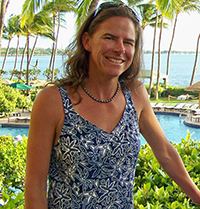Nationality USA | ||
 | ||
Institutions Desert Research Institute Alma mater BS California Polytechnic State UniversityMS San Francisco State UniversityPhD University of California, Santa Barbara Notable awards Nevada System of Higher Education Regents Researcher Award (2014) | ||
Alison Murray is an American biochemist and Antarctic researcher, best known for her work demonstrating the existence of microbial life within an ice-sealed Antarctic lake (Lake Vida). She studies how microorganisms persist and function in extremely cold and harsh environments, including those that lack oxygen and biological sources of energy.
Contents
Early life and education
Murray was born and raised in Carmel, California and attended Carmel High School. She received her B.S. in Biochemistry at California Polytechnic State University, San Luis Obispo in 1989, followed by participation in a work-study program that turned into a Research Assistant position at the Bermuda Institute of Ocean Science (formerly, Bermuda Biological Station).
Following two years of work experience she joined the Biogeochemical Reactions in Estuaries - Land Margin Ecosystem Research Program at Tomales Bay, earned her M.S. degree at San Francisco State University in Cell and Molecular Biology in 1994 where she studied with James T. Hollibaugh to develop molecular fingerprinting approaches for marine microorganisms.
Murray’s Ph.D. was earned in Ecology, Evolution, and Marine Biology under the mentorship of Edward F. DeLong, from the University of California, Santa Barbara in 1998. It was during this time that she participated in two research expeditions to the Antarctic where she studied the ecology of planktonic marine Archaea (Crenarchaeota) with circumpolar distributions and demonstrated significant shifts in bacterial community composition and archaeal biomass over the extremes of the high latitude seasonal cycle.
Career and impact
Murray’s postdoctoral research (1999-2001) was conducted at the Center for Microbial Ecology at Michigan State University in which she studied in the emerging field of functional genomics with Distinguished Professor James M. Tiedje. She then moved to Desert Research Institute (DRI) in Reno, Nevada, USA in 2001 where she is a research professor.
Murray is best known for her work discovering the existence of microbial life at −13 °C existing within an ice-sealed the Antarctic Lake Vida, the largest of several unique lakes found in the McMurdo Dry Valleys. This research finding was profiled by BBC TV, National Public Radio, and in the international news media including The Guardian, Los Angeles Times and Nature.
Murray’s research has provided critical insights into how microorganisms persist and function in extremely cold and harsh environments, including those that lack oxygen and biological sources of energy. Making use of molecular genomic tools to describe microbial life, her work has helped answer questions about how microbes function and survive in extremely cold environments and how environmental changes affect the functioning and diversity of these organisms, as well as potential feedbacks that might impact the sustainability of cold-environment ecosystems.
The research has altered the scientific view of biological diversity in high latitude ecosystems where microbes are significantly more diverse than originally surmised and exhibit strong seasonal gradients in community composition; they have been found to exist in places originally thought to be uninhabitable.[1].
Her research has shown how microbes respond to different environmental gradients and how they contribute and control fundamental ecological processes resulting in a better understanding of how high latitude ecosystems function and how they might respond to broad scale perturbations such as climate change. (e.g.).
Awards and honours
Murray was recognized with the Nevada System of Higher Education Rising Researcher Award in 2009 and the Nevada Regents’ Researcher Award in 2013.
Other activities
Murray served as Representative to the Life Sciences Standing Committee for the US in the Scientific Committee on Antarctic Research for eleven years and played roles in the Census of Antarctic Marine Life, and in biodiversity data management.
